A little over a year ago, I began experimenting with ways to expand my Dolby Atmos surround sound system to beyond the 7.1.4 limitation of current consumer hardware. My continued quest to achieve the best Atmos experience at home has recently driven me to make additional upgrades. These days, my home theater is so crazily complicated that I actually need to run three A/V receivers simultaneously to manage all my speakers.
In most home theaters, 7.1.4 channels of sound should be plenty enough. Even though the Atmos format (as well as its competitor, DTS:X) can support additional speakers, there hasn’t been much demand for that from consumers or much push from manufacturers to do it. Currently, only boutique high-end products such as the $37,000 Trinnov Altitude 32 will decode more than 11 channels at once.
Nonetheless, for some of us, a limit of four height channels isn’t enough to fill the top of the room with sound. My own home theater is a long room with a lot of space behind my seats. That, combined with a low ceiling, makes it difficult for just four speakers (two in the front of the room and two in the back) to image a sound above my head convincingly. This issue is compounded by the fact that the locations where I had installed speakers when I built the home theater (before immersive audio was a concern I gave any thought to) were less than ideal for Atmos. Those speakers are now fixed in place with wiring through the walls and ceiling, and I can’t move them without remodeling the room. That simply isn’t an option.
The better solution is to install additional speakers in the center between the other height channels (Top Middle position). Unfortunately, the asking price for that Trinnov processor is absurdly beyond my budget. I needed to find a way to jury-rig a similar effect for a fraction of the cost.
The First Attempt
I wrote an article last year explaining how I had cobbled together a convoluted system (jokingly dubbed “Zatmos”) utilizing a second A/V receiver to derive extra channels on my ceiling. I advise reading that piece to understand the basic concept of how such a thing is possible.
Even at the time, I was not the only person experimenting with this, and I knew that my Zatmos system was not as ideal as I would have liked it. Over at AVSForum, a member named Scott Simonian had gone even further to use a total of three A/V receivers in unison to create a 7.1.6 configuration (affectionately known as “Scatmos”) more accurate to the intentions of the original Dolby Atmos sound mixers.
For a while, I decided not to go that far. The complexity of installing, connecting and configuring three A/V receivers seemed like overkill to me. I felt that the results I had with Zatmos were good enough to get me most of the way there, and I had a certain amount of egotistical pride that I’d figured out a way to do it with just one extra receiver rather than two.
However, in recent months, my attitude changed and I grew less satisfied with the Zatmos configuration. Eventually, I knew that if I was going to do this, I needed to do it right.
Going Full Scatmos
The silly Zatmos and Scatmos nicknames can be more formally grouped under the heading of “Dolby Atmos Extended.” I want to be clear here that I did not develop the Scatmos process. Credit for that goes to Scott Simonian and others at AVSForum who helped him work it out. With his permission, I’m just trying to explain it here.
For as perhaps ridiculously complicated as they may be to install, one of the saving graces of these experiments is that they can be assembled relatively inexpensively. Although your primary A/V receiver must be a Dolby Atmos (or DTS:X) model capable of decoding 7.1.4 channels of sound from a Blu-ray or UHD immersive audio soundtrack, the secondary receivers don’t need to be nearly as fancy. Any receiver that has, at a minimum, Dolby ProLogic II processing will do. (If using multiple secondary receivers, I recommend that they be identical to each other.)
With a little patience while monitoring For Sale ads on my local Craigslist, I managed to pick up a pair of used Marantz SR4400s for well below $100 each. This is a no-frills, entry-level (or close to it) Dolby Digital/DTS model from 2003. It’s so basic that it doesn’t even have an on-screen menu system. I have to set it up using only the front panel display. The receiver doesn’t have HDMI and cannot handle lossless Dolby TrueHD or DTS-HD Master Audio signals, but it doesn’t need to. All it needs is a pair of analog stereo inputs (which any receiver will have) and ProLogic II.
The simple act of finding a place to put another A/V receiver in my system proved to be far more of an ordeal than I wanted. Because I didn’t have enough space for it on my main equipment shelf, I had to remove all my components, take the shelf apart, rearrange the levels, put most of the equipment back, and hook it up again. Then I had to do the same thing with the second shelf in order to add a level. My Blu-ray and HD DVD players, which had previously been on the main shelf, moved over to the second so that I could keep all the audio equipment together where the speaker wire will reach it. This, in itself, was a tremendous pain to do.
With that finished, here’s the basic idea behind Scatmos: You want to mount six ceiling speakers – in the Top Front, Top Middle and Top Rear positions. (The following sketch does not represent my personal speaker layout, but I’ve drawn it this way to show how it should be done.) Your primary A/V receiver will be set to decode its maximum of 7.1.4 channels, configured as Top Front and Top Rear.
All four of the height channels should be routed to the analog pre-out connections on the primary AVR. You should not attach any speaker wire to those channels on the primary AVR. For all of the height channels, speaker wire will be attached only to the secondary AVRs.
The pre-outs for the Top Front Left and Top Rear Left channels will go into the Right and Left stereo inputs on AVR 2.
The pre-outs for the Top Front Right and Top Rear Right channels will go into the Left and Right (reversed from AVR 2) stereo inputs on AVR 3.
If that sounds confusing already, trying to keep it straight while actually connecting the cables and wires can be truly daunting. I strongly recommend drawing a chart that shows what should go where.
When working properly, each of the secondary downstream AVRs should take a stereo signal consisting of part Front and part Rear, and matrix a Middle channel between them using any mono information in common to both (much as ProLogic II would extract a center channel for dialogue in the front of your room between your left and right speakers under normal circumstances). Thus you get six channels of height information from an original four.
That’s the theory, simplified to its most basic elements. Actually getting it to work properly after your connections are made has some added levels of difficulty that I’ll cover soon in Part 2.

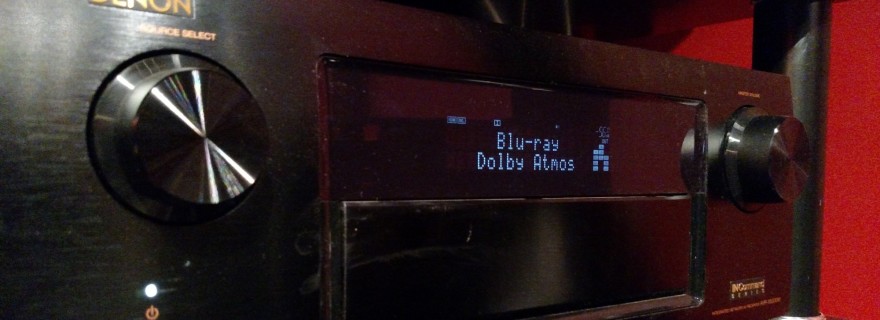
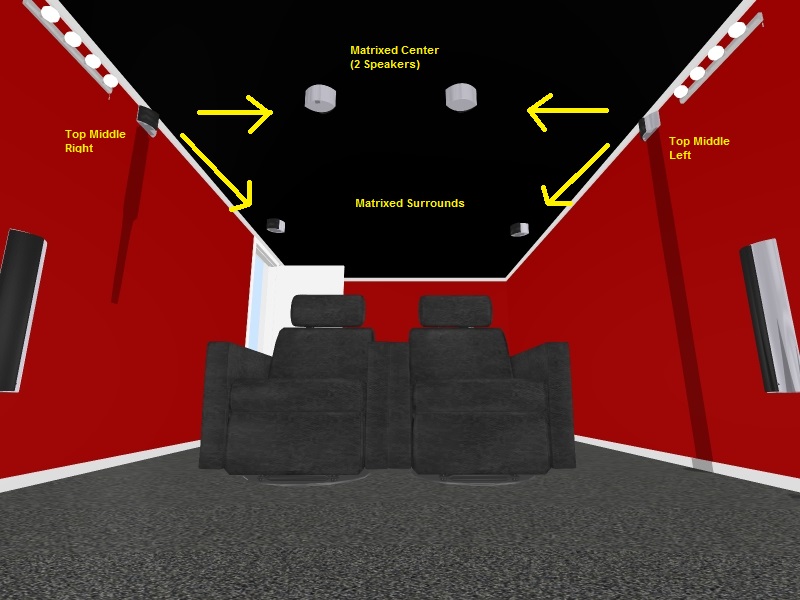
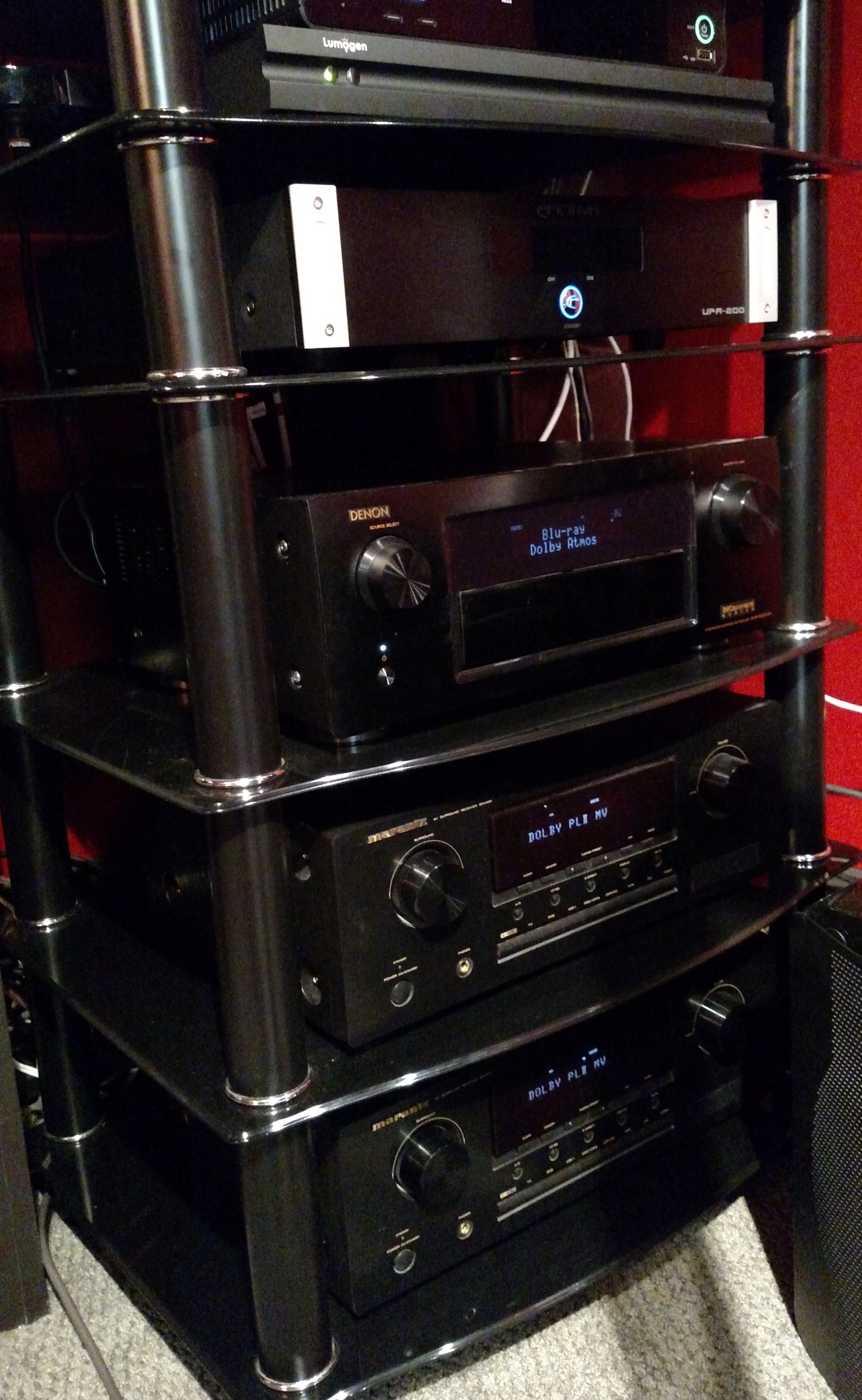
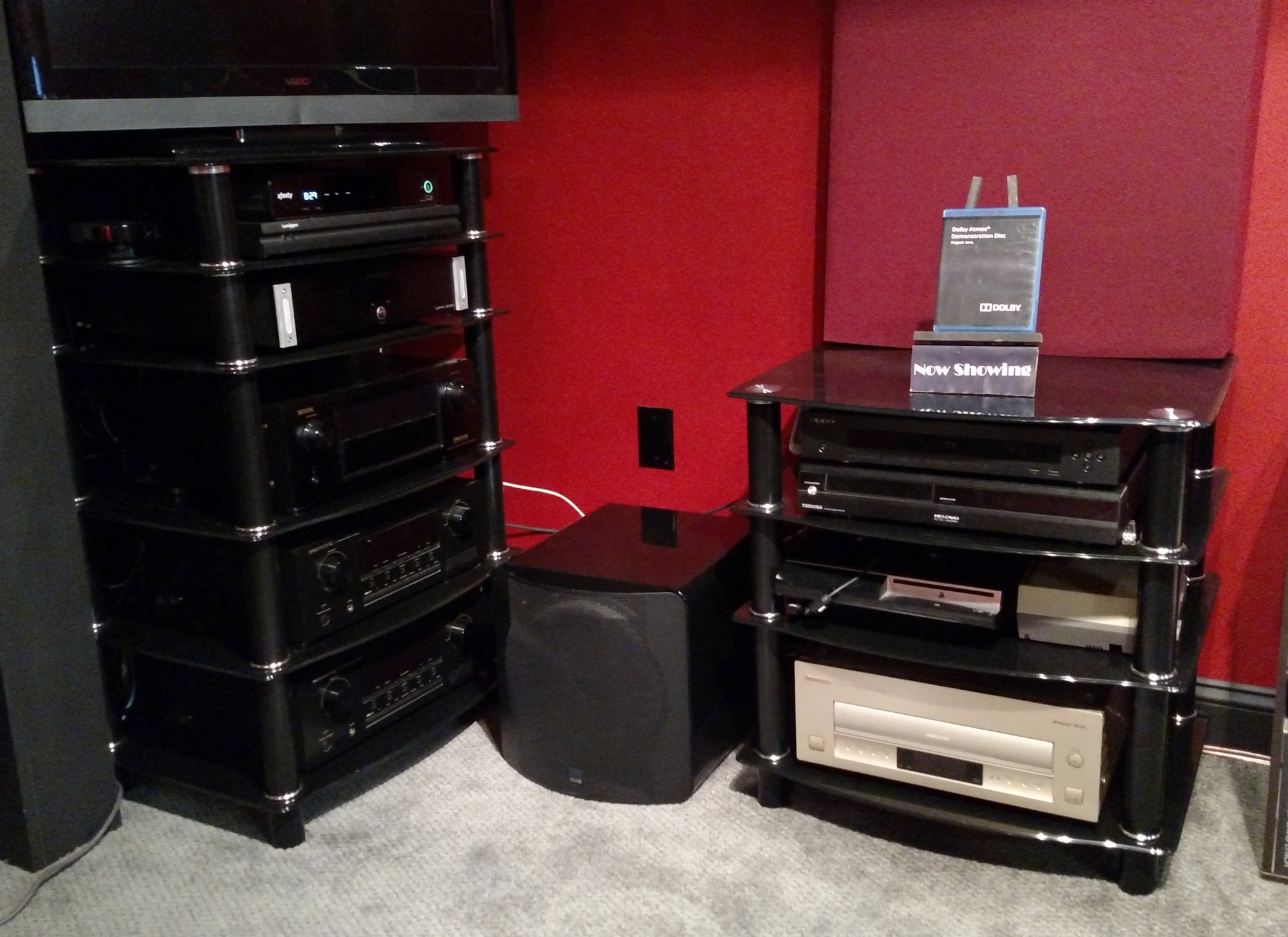
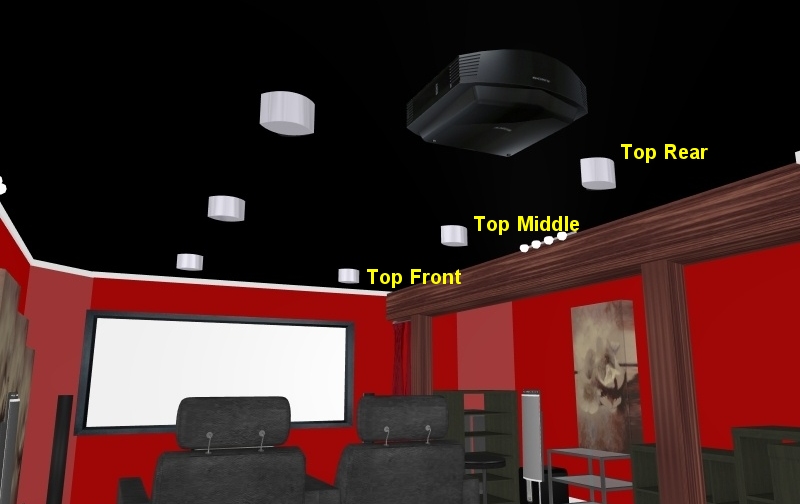
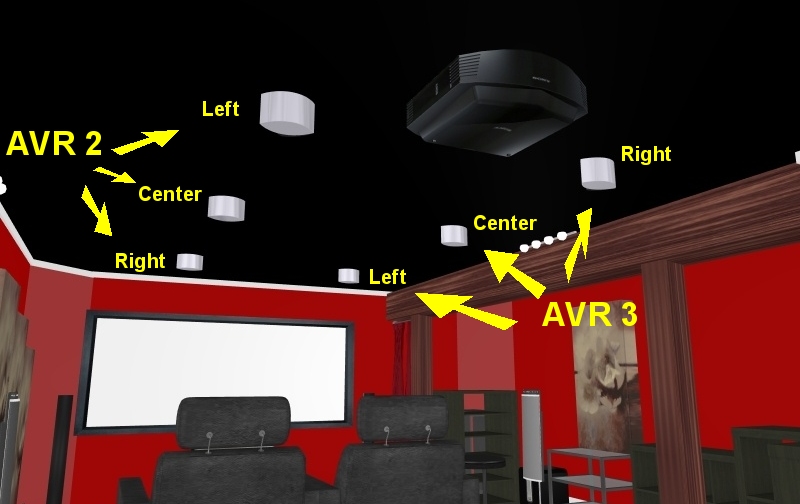
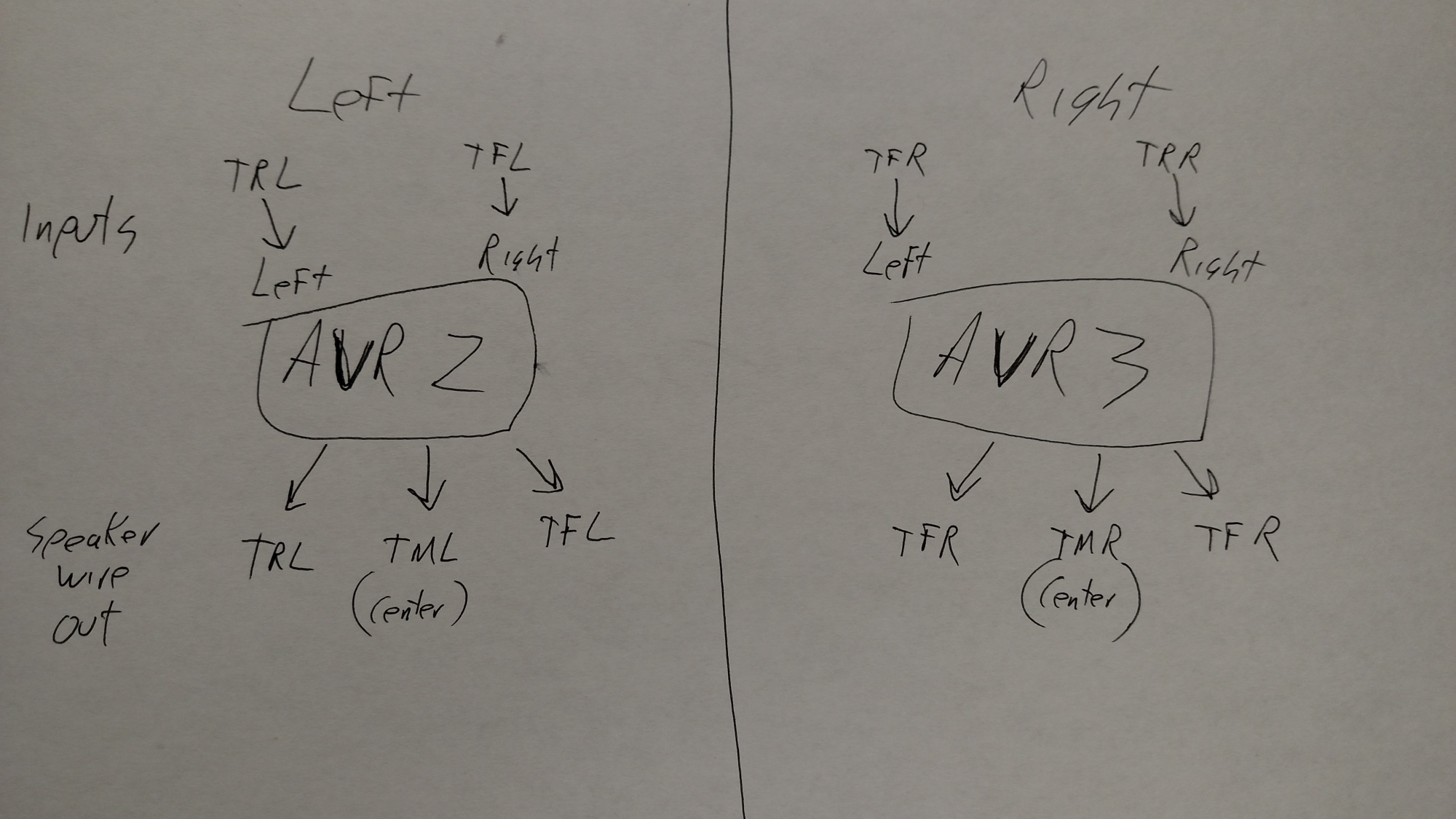

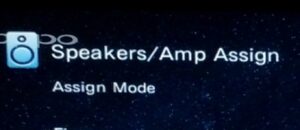
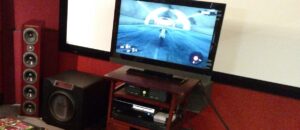
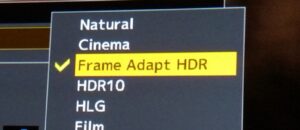
-A.
Haha this is AWESOME!!!! Please!! Second part can’t come soon enough! 😀
Csm101
Friendly suggestion, I think Scottmos or Scotmos would sound a little less poo pooey than Scatmos. Maybe that’s what he was going for…anyways great article. When can we see the rest of it?
Josh Zyber
AuthorYeah, I agree, but I didn’t name it. 🙂
I prefer to pretend he was thinking of scat music. Skeetle-at-de-op-de-day… Skeep-beep de bop-bop beep bop bo-dope…
Scott Simonian
Yeah. I agree which is why I used the naming Atmos-EX (named after the Dolby Digital EX method used here) but Scatmos stuck. ¯\_(ツ)_/¯
Thanks for the shout out, Josh!
Look forward to Part 2. :0)
Ross
Great article.
Josh, what Audyssey Curve do you use in your room? I have always used flat but since upgrading from a Denon X3000 to Marantz SR7009 I have been enjoying the Reference curve especially when using the Atmos decode. It just sounds warmer and fuller. Just curious on what you use.
Ross
Josh Zyber
AuthorAudyssey will be covered in the next part of the article. I generally use the Flat curve because I find that Reference rolls off too much high frequency info and I don’t like the sound in my room. However, as it turns out, Audyssey plays havoc with the Scatmos process. (Apparently, it did with Zatmos as well, but I didn’t realize just how much.)
Troy
Datasat RS20i Surround Sound Processor: 16 discrete channels, DTS:X/Atmos ready, $15K cheaper than the Trinnov.
http://hometheaterhifi.com/reviews/receiver-processor/datasat-rs20i-surround-sound-processor-review/
Troy
Oh, and it’s upgradeable to 24 channels!
Josh Zyber
AuthorOh, well, only $23,170? That changes everything! Where did I leave my wallet? 🙂
EM
Whoops! My mistake. When I saw “Oh, well, only $23,170? That changes everything! …” in the Recent Comments, I clicked it under the assumption it would take me to the “Middle-Earth Collection” poll.
William Henley
When you can pick up a Christie projector for cheaper than your receiver, then you know there is an issue!
Ross
Interesting. Audyssey & Atmos in my room sounds incredible. However, I also did not like the sound of Audyssey Reference in my room with my old X3000. I felt it lacked detail but I also found the Flat curve too harsh which is why I upgraded to the Marantz with XT32. I have Paradigm Monitors which are a little forward so the Marantz tames them quite nicely.
Thanks for your reply! Can’t wait for part II!
Josh Zyber
AuthorAudyssey and normal Atmos work fine together. However, when you start adding extra receivers downstream, Audyssey is very problematic.
Ronald Moody
How is volume controlled in this setup? I’m assuming the primary AVR controls volume to the pre-outs?
Scott Simonian
Volume is controlled from the main AVR only. It’s rather easy when following this same method. You set the levels and everything during setup of the two extra receivers. Once you have everything dialed in, you no longer have to control anything on the two extra receivers and simply control everything on the main AVR. Set and forget.
Just don’t forget to turn on ALL the receivers when watching stuff. 😛 “Hey! how come things don’t sound right. Where is all the overhead stuff? Oh….*facepalm*
William Henley
This makes sense. My first 7.1 only had 5.1 powered. I ran it into an old amp I had. Once it was set, you didn’t have to mess with the volume on the second amp again, you just controlled the volume on the main receiver.
Josh Zyber
AuthorBoth of the secondary AVRs should be set for reference level (0 dB) and left there. You’re using them like amps, just with the addition of ProLogic II. Volume is controlled by the primary AVR. When you raise or lower the volume on that receiver, it changes the signal sent through the pre-outs.
Julian
Speaking of ‘Zatmos’, where does the word ‘Zyberdiso’ come from?
Once, more than 10 years ago, I was researching LaserDisc (because I wanted to buy a used player). I found Josh’s site (years before The Bonus View). Afterwards, I wanted to visit the site again, but couldn’t find it via Google. Then I found out why: I had been using the search term ‘ZyberDISCO’.
Josh Zyber
AuthorIt’s just a play on Cinema Paradiso.
Julian
Ah, I had never heard of the film. Italy, 1988, apparently. Thanks for the information!
Javan Pohl
In all these variations, did you ever experiment with how well a true, straight 7.1.2 (with the actual overheads) works in your room? It might work so well in my situation because my overheads are about 7-8 feet above the listener position, if they were normal ceiling height they might be far too easy to localize, but my set-up allows for fantastic phantom imaging between the height and lower speakers. I don’t really feel like I’m missing anything. For me it’d either be .2 or .6, .4 (unless you can do a true top-height plus top front or rear–not always an option) seems akin to having a left and right center channel speaker instead of one right in the middle.
Also, I’ve always been a fan of Scott’s design (and Scott himself–one of the best AVS users there is), but I would have reservations about throwing low-grade receiver circuitry into the mix. For once I finally have a receiver and amplifier combo that is dead silent when I crank up the volume (i.e. no hiss) and sound quality is otherwise crystal-clear. Don’t know if I ever asked Scott, but did you notice any changes in sound quality going to your .6 set-up?
Juan
Honestly, I would prefer a center rear and center height channels. Maybe 2 extra front speakers? 🙂
William Henley
The sad thing is, that is how I thought Atmos was supposed to work (I think DTS X does that) – you pretty much put your speakers wherever, and have as many as you want, and then you used like a 3D mic and it would self configure. so if you wanted that extra side channel (long rooms) or extra rear center, you could get it.
Actually, I bet you probably could do an extra rear center. Take the rear two channels (especially if you have an amp that doesn’t power the rear – so like an older 7.1), then run it into a secondary amp that has prologic and a front center. Then use the front channels on your secondary amp to run your rear left, right and center. Should work pretty well
Josh Zyber
AuthorDTS:X works the same way Atmos does. You have to select from a pre-defined list of speaker locations in the receiver setup menus. The DTS:X marketing hype about “Put your speakers wherever, we’ll figure it out” was a lot of bull.
Scott Simonian
No you don’t. Center rear is wildly inferior to stereo rear surrounds. A center rear directly behind will cause “image reversal”. What that is is when a sound is played (usually briefly like most effects) the sound appears to image in front of you at the front center channel when in fact it’s playing behind you. A little trick our brain does. Have you tried 6.1 surround before? This is very common and no go at all.
Auro3D has support for a center height channel. That’s not a terrible idea but unneeded in the vast majority of domestic applications.
Scott Simonian
As long as the center rear is supported by two speakers (in mono) then I would advise against it.
Csm101
Question here. I couldn’t find the right place to post it, so I guess here’s good enough. I did some rewiring on my theater rack because my VCR DVD burner crapped out so I figured I’d clean house. I have two Bluray players, one is an older Sony from about 2009 with only one hdmi output. The other is a 3D Panny with two hdmi outputs because I have a legacy receiver that doesn’t have 3d pass through, so in order to get lossless and 3d, I needed a player with both. I like having two players so I can do picture comparisons whenever a newly remastered bluray comes out, so I decided if I wanted to compare audio tracks as well and more efficiently,( i.e., pcm track on an older disc vs DTS track on newer disc) I would wire the old Sony through the receiver, which then goes to the TV, but that means in order to watch anything in that player, I always have to turn my receiver on. I don’t have to do that with my Panny because of the dual outputs. The question is, is there a setting on the receiver or the bluray player that will allow the signal to pass through without having to power it on? I’m aware the equipment is a little older and if it can’t be done, then that’s ok, but I’d figure I’d give it a try. Thanks in advance to anyone with input on this.
Eric
hey guys liking all this conversation im a little confused even though ive read the atmos manual for engineers -the mixer has 10 channels and 10 only .i realize that we can set up 34 channels but from what ive studied it sounds like say the front heights and wide fronts are the same channel information as the ear level fronts and again the front tops and rear tops are the exact same two channel stereo or mono only not at all truly four channels the atmos mixer only has 10 or 9.1 channels count them out! theres not enough to get four top speakers 7.1 .2 thats two distinct stereo channels in the top set up, in the Manual they just call it good old fashion 9.1 no fancy 11.1.4 i guess with some sort of delays the objects and metadata pan to all the other 24 channels? yes
Josh Zyber
AuthorI’m not sure what manual that is or what any of that means, but an Atmos soundtrack does have discrete audio to all speakers. The Dolby Atmos demo disc has an audio test where a helicopter circles the room from Top Front-Left to Top Rear-Left, then over to Top Rear-Right and Top Front-Right.
I think perhaps you’re confusing the difference between “bed channels” and “sound objects.” An Atmos soundtrack is built on a base of 7.1 bed channels, just like a traditional soundtrack. The mixer decides what speaker he wants a sound to come from, and he puts it in that specific speaker. On top of that, Atmos adds sound objects that are not tied to specific speakers. Sound objects move through the three-dimensional space in the room, and the decoder maps them to whatever speaker is closest to their intended location.
Eric
hey Josh thanks for posting all your findings very interesting and thoroughly done job but wait it doesn’t help me lol because it seems at the moment a 7.1,4 or an 11 channel amp costs minimally what $3000 and im not buying in at that price so in a couple days im getting the Sony str dn1080 5.2.2 for $600 call me cheap or stupid but i want that receiver for a lot of other reasons also including the price so Josh ive been trying to figure out how im going to fake it(7.1.4) till i make it lol- (make serious dough that is ) because theres no poor boy 7.1.4 receiver yet. so can you start over with a 5,1,2 system and teach us how to do one of them up lol ? im sure your saying hells NO! thanks 🙂 remember your the Boss! of Atmos youve created Zacmos lol u kin do it!!!!! so do us poor boys a favor and design a set up for us
Josh Zyber
AuthorUnfortunately, there’s no way to expand a 5.1.2 receiver to more channels. You’d need to start with a receiver that can decode at least 5.1.4.
I don’t know where you’re located, but a 7.1.4 receiver shouldn’t cost you $3,000. If you’re in the U.S., accessories4less.com currently has a Marantz SR6011 for $949.99. This receiver has 9 channels of built-in amplification, but can decode 11 channels (7.1.4) if you add an external amp, which should only cost a little over $100. Yes, this is more than the $600 you’re planning to spend now, but it’s nowhere near $3,000.
Eric
Thanks i’ll look into that model, i must have missed that one, that’s somewhat reasonable to be able to do 7.1.4
Eric
the Marantz sr6011 is available @ accessories for less its refurbed but seems to be the most inexpensive way to get true 7.1.4 Crutchfield is sold out @ the normal list price of $1399
MagnumX
I’m thinking that it would be much simpler (in 2018) to buy the Denon AVRX8500H to handle the same setup without three receivers (probably not cheaper, though, although it would allow Auro 3D to be used as well, but you’d have to load the configuration to share top middle with surround height as it won’t do it as-is). The problem I’ve got is similar to the room here that the angles are too low for front/rear height given the length of the room, etc. The second problem is that once you get used to “dialog lift” on a Yamaha receiver, you don’t want to go back to having sound BENEATH the projection screen. Your brain kind of tunes it out because you see their mouths moving, but once you hear it with dialog lift, it’s a revelation. The sounds appear to come from the actual screen and it’s night and day. The front image is then as big as the screen and it FEELS like a real movie theater “front” instead of a “home” theater. It’s even awesome with mono soundtracks (e.g. Maltese Falcon and with a mono processing mode, you feel like you’re a giant theater with your eyes shut).
The problem is, of course that Yamaha doesn’t offer a 13-channel receiver, not even a processing one. The biggest they go is 9.1 with 11.1 processing (external amp required to use 11.1). The A3070 can’t even configure a 5.1.6 setup (Yamaha can FAKE/SIMULATE the rear surrounds for the main listening position, so you’d think 5.1.6 would be THE option to use with it, but no. They don’t offer it at all. They don’t offer Front Wides either as an option. The Denon AVRX8500H offers everything BUT dialog lift (Why not? Who knows. I doubt it’s a protected “format” as it’s just the fronts + center mixed into the top fronts; in other words it’s a front channel phantom speaker signal to the top front speakers.
The only way I can think of to get “dialog lift” for the front channels with the Denon is to use another receiver. I could either use a Yamaha receiver to pull the presence signal from the pre-out front outputs (the problem here is that it needs the stereo L/C/R SUMMED signal you’d get with a phantom center mode. But if you set the Denon to phantom center, you no longer get your actual bed channel center speaker working! That’s a problem. You could just pull the center output instead, but that would only lift dialog, not the entire front soundstage and movies with “panned dialog” would move up/down as they pass from left or right through the center (unless of course your left/right speakers are to the left/right of your screen mid-way up. Mine sit underneath so it’s no good).
You could use an external HDMI box with optical signal extraction to send the front bed 5.1 channels to the second receiver. This would give it the full untouched signal and thus it could easily extract a true presence channel directly or even skip DSP and just use stereo front output mode (use volume trims to set the “height” relative to the Denon). The only real problem here (other than it’s using lossy audio for the presence speakers which may or may not bother someone mentally; you could get around this if you had a receiver with HDMI full out that passes through to the next receiver unharmed) is that you would need to change the volume on two different receivers (and hope they really are in 1dB increments as labeled). If both receivers were Yamaha, that would probably work from one remote button push (well maybe).
But then if Yamaha did at least 5.1.6, I probably wouldn’t need the Denon in the first place (you could easily extract a TRUE discrete rear surround using a second receiver if that WERE the case by sending it a full base signal (optical/hdmi) and then using the second receiver to handle rear surround AND side surround (i.e. to keep the rear channel info out of the side surround channels that the unit that wasn’t set to use rear surrounds would inevitably put in there).
Then there’s the “FRONT WIDE” signal still not handled in the 7.1.6 configuration (you could go 9.1.4 instead to get it from the Denon 8500H). Of course, with two extra receivers (or at least decoders and amps) you could matrix these channels using PLII with FL + SL and FR + SR, which would help fill a gap in many rooms between the front speakers and the side surrounds. Or we can wait until Denon puts out a 15 channel amp…. (really they just need 15 channel processing; even an 11 channel amp in the receiver would be fine. 2-channel 100 watts amps aren’t that expensive (I’ve seen many new for $100).
If you think about it, they could design these chips to “daisy chain” if they really wanted to cut prices down for the more exotic configurations. The chips would just need to configure in such a way that they know you already are using whatever other channels so they extract the remaining ones properly. Think about it. You could just buy two 5.1.2 (7-channel) receivers for less than $1000 (probably an average of $800 or so) and get 14.1 channels out of them (9.1.4 + an extra VOG channel) or two 11-channel models for around $3000 and have 22 channels! (imagine 13.1.9!!! with a top center to boot). That would cover 4-6 rows of seats cleanly for a fraction (1/10) of the cost of a Trinnov setup ($30K?)
ANDY SUMMERS
atmos fake upmixes of old, outdated movies, just make the movie a Cash atmos Cow. same could be said about, auro3d and dtsx. They are just Cash Overhead Cows.
Latest fake atmos is the final countdown 1980. Where it sounds like the mixer has taken front L R and simply applied it to middle height 2 as that is where it is going to on my denon avc-x8500h, not much in height 3, very little in height 1.
It’s height 2 that sounds distracting, distracting me away from the movie, that I seen many times, it’s okay cult sci-fi classic.
The LR front typically as dialog that sounds foggy with it being more dB louder of course on centre with effects and music the mix is discrete over the LCR and the foggy dialog is typical of some movies, that was mixed with that trend style it’s not an error.
What I always do to check if an atmos mix is decent enough is I Mute the LCR surround LFE.1, though the multiples of Behringer DCX2496 so I can monitor the overhead surrounds to see if they have correct sound continuity, that they don’t have bizarre sound coming from the overhead when it is related to the front on-screen or doesn’t have sound errors of any dialog leakage or effects leakage from the front. I am listening for sound elements that have been newly created if or so from the Stem tracks, that makes up a film soundtrack.
I am also listening for music to see if the mixer has artistically removed certain music elements to create an uplifting harmony effect, that I have only heard in decent 6 ch mixes. Often most music in atmos upmixes sound like the mixer has simply taken the music as a whole element and placed it on the overheads to Fool or trick us or most sheep atmos masses into believing its a really great atmos, when in fact they are not, doing a good mix rather than a quickly rushing it to get out on the shelves in shops to Cash atmos Cow it all. Shame on these re-recording mixes, shame on them, and the studio and Shame on dolby labs as well and dtsx and auro3d, Cash Cow money grabbers.